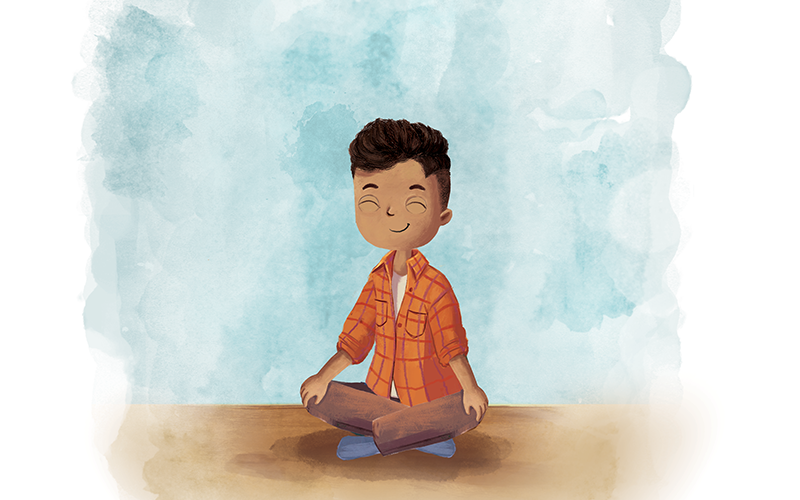How to Foster Mindfulness at Home

Living in a world with complex issues and stressors can often inhibit our abilities to stay calm, focused, and clearheaded. It can feel impossible to slow down and concentrate on being in the moment. Fortunately, there are numerous ways to welcome the practice of mindfulness into our routines that can help us to deal with everyday emotions, improve overall well-being, and reduce the impact of negative thoughts and feelings.
What Is Mindfulness?
Mindfulness is the intentional awareness and acceptance of the present moment. This means taking the time to sit and consider the thoughts and feelings passing through our minds and then observing them without judgment (Amundsen et al., 2020). It also means considering the environment we are in and how that may impact our thoughts and feelings. Being mindful is about allowing ourselves to exist fully within the present moment. This practice is considered to be a constructive way to mitigate the impacts of negative buildup and suppression of feelings such as anxiety, anger, and fear (Keng et al., 2011). In time, mindfulness can greatly improve our quality of life.

Why Is It Important to Practice Mindfulness?
Both children and adults will benefit from having positive ways to navigate overwhelming emotions. In adults, mindfulness has been seen to improve memory, concentration, and emotional regulation. In addition to this, adults that have implemented mindfulness into their lives have a greater capacity for compassion and empathy towards others (Jennings et al., 2012). It’s important for both teachers and parents to understand the positive impacts that practicing mindfulness can have and how to meaningfully share these practices with children.
Mindfulness practices have proven to be beneficial when it comes to several facets of overall well-being, including managing emotional problems and handling stress. Children are also seen to have improved reports of life satisfaction and are more prone to a positive outlook on life after regularly engaging in mindfulness practices (Amundsen et al., 2020). If we provide children with the tools to enhance their emotional capabilities from a young age, they will be more likely to perform better in school, foster healthy relationships with others, and experience improved mental health.
How to Practice Mindfulness
One of the great things about mindfulness is how easy and enjoyable it can be. As parents and teachers, we play a crucial role in showing children ways to explore mindfulness early on and develop lifelong habits that will improve their well-being and emotional capabilities. Consider the following ways that mindfulness can be brought into the home:

- Movement. At home, it is important to teach children how they can move their body and be mindful at the same time. This could look like taking a calming walk or doing some yoga while tuning in to the feelings our bodies and minds are experiencing.
- Gratitude. We can encourage children to practice gratitude by asking them to talk about or write down three or more things that they are grateful for. Studies show that gratitude in particular is linked to better sleep, reduced depression, and a greater ability to foster positive relationships with others, among other benefits (Wood et al., 2010).
- Meditation. Sitting quietly with our thoughts can be a challenge, but putting on a guided meditation or some music and finding a comfortable position is a great way to be mindful. Check out some of our Mindful Monday guided meditations.
- Breathing exercises. Encourage slow, deep breaths. Remind children that this exercise can be used any time they are experiencing distress as a way to return to a state of calm.
Implementing these exercises for just 5–10 minutes a day can result in tremendous benefits. Remember to lead by example; when children see the adults in their lives practicing mindfulness, they will be more likely and willing to model this behavior. With mindfulness, we can set our children up for happy and successful lives.
References
Amundsen, R., Riby, L. M., Hamilton, C., Hope, M., & McGann, D. (2020). Mindfulness in primary school children as a route to enhanced life satisfaction, positive outlook and effective emotion regulation. BMC Psychology, 8. https://bmcpsychology.biomedcentral.com/articles/10.1186/s40359-020-00428-y#Sec26
Jennings, P. A., Lantieri, L., & Roeser, R. W. (2012.). Supporting educational goals through cultivating mindfulness: Approaches for teachers and students. In P. M. Brown, M. W. Corrigan, & A. H. Higgins-D’Alessandro (Eds.), Handbook of prosocial education (pp. 371–397). Rowman & Littlefield. https://www.researchgate.net/publication/235324459_Supporting_educational_goals_through_cultivating_mindfulness_Approaches_for_teachers_and_students
Keng, S.-L., Smoski, M. J., & Robins, C. J. (2011). Effects of mindfulness on psychological health: A review of empirical studies. Clinical Psychology Review, 31(6), 1041–1056. https://www.ncbi.nlm.nih.gov/pmc/articles/PMC3679190/#__ffn_sectitle
Wood, A. M., Froh, J. J., & Geraghty, A. W. A. (2010). Gratitude and well-being: A review and theoretical integration. Clinical Psychology Review, 30(7), 890–905. https://doi.org/10.1016/j.cpr.2010.03.005




